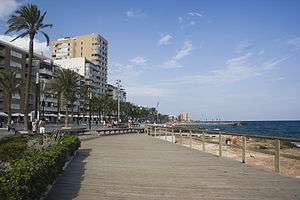Costa Blanca
Costa Blanca (Valencian: [ˈkɔsta ˈβlaŋka], Spanish: [ˈkosta ˈβlaŋka], literally meaning "White Coast") refers to over 200 kilometres (120 mi) of Mediterranean coastline in the Alicante province, on the southeastern coast of Spain. It extends from the town of Dénia in the north, beyond which lies the Costa del Azahar (or Costa dels Tarongers), to Pilar de la Horadada in the south, beyond which lies the Costa Cálida. Costa Blanca has a well-developed tourism industry and is a popular destination for British and German tourists.
The localities along the Costa Blanca are Alicante (Alicante/Alacant), Altea, Benidorm, Benissa (Benisa), Calp (Calpe), Dénia (Denia), Elche (Elche/Elx), El Campello (Campello), Finestrat, Guardamar del Segura, L'Alfàs del Pi (Alfaz del Pi), Orihuela Costa, Pilar de la Horadada, Santa Pola, Teulada–Moraira, Torrevieja, Villajoyosa (Villajoyosa/La Vila Joiosa) and Xàbia (Xàbia/Jávea). Benidorm and Alicante cities are the major tourist centres.
History
In 711 AD the Moors invaded Spain through Gibraltar and would occupy the region of Alicante by 718 AD. Their occupation was to last nearly four hundred years and would mould the landscape of the region. The Moors introduced irrigation and the planting of oranges, peaches and almond orchards. The terraces seen on the hillsides throughout the region are an everlasting Moor legacy. The Moors would not be completely expelled until 1492, when Ferdinand and Isabella, the Catholic monarchs, finally took control of Granada. In 1095 Spain became part of the North African Muslim Empire and for another four hundred years the Moors and Christians would fight over control of Spanish soil. Alicante was gradually regained from the Moors in 1248 by James I of Aragon. After their expulsion, the Moors continued to attack Spain. Between 1500-c1650 Berber pirate attacks were frequent all along the Mediterranean coastline. The first Spanish Constitution was written in 1812 and following this the provincial boundaries were established, establishing the regions including Alicante and Murcia as they are today. In 1923, Miguel Primo de Rivera took control of Spain as a dictator, eventually forcing Alfonso XIII into exile. The Spanish Civil War, (1936–1939) would divide the country. Alicante and Murcia would remain supporters of the Republican movement. In 1939 General Francisco Franco, the leader of the nationalists took control of Spain. During the 1960s and 1970s tourism exploded throughout the region to nearly 4,000,000 visitors a year to reach around 6,000,000 tourists a year in recent years.[1]
Image gallery
- Costa Blanca gallery
-

Alicante harbour
-

Monjas-Santa Faz, Alicante
-
Street in Altea
-

Beach in Calp
-

Dénia fortification
-

Palm trees in Elche
-

Coveta Fumà in El Campello
-

Montgó Massif
References
- ↑ ?
- 'Guide to yacht clubs and marinas in Spain : Costa Blanca, Costa del Azahar, Islas Baleares' (Madrid: Ministry of Transportation, Tourism and Communications, General Office of the Secretary of Tourism, General Office of Tourism Companies and Activities, 1987)
External links
- Costa Blanca Tourism, official website by the Diputación Provincial de Alicante
- Information about Costa Blanca, official website for Tourism in Spain
- Costa Blanca Photos




